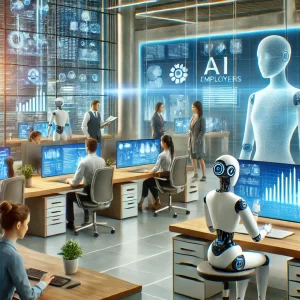The rise of artificial intelligence (AI) and automation is reshaping the global workforce at an unprecedented pace. From manufacturing to customer service, AI-powered systems are transforming the way businesses operate — leading to both excitement and anxiety among workers. While automation brings undeniable benefits like efficiency and cost reduction, it also raises concerns about job displacement and the need for reskilling. To stay relevant in this evolving landscape, individuals must embrace continuous learning, adaptability, and a proactive mindset. This article explores the multifaceted impact of AI and job automation, weighing the merits and demerits while offering strategies to thrive in the changing workforce.
The Rise of AI and Automation
AI and automation are no longer confined to science fiction. In reality, these technologies are integrated into various sectors, enhancing productivity and reshaping job roles. Automated machines now handle repetitive tasks in factories, while AI algorithms power virtual assistants, chatbots, and data analysis in service industries. Self-driving cars, robotic process automation (RPA), and advanced machine learning models continue to push the boundaries of what machines can achieve.
The pandemic accelerated this shift as companies sought to maintain operations with reduced human interaction. As a result, automation adoption surged, prompting a rethinking of traditional job structures.
Merits of AI and Job Automation
- Increased Efficiency and Productivity: Machines can operate 24/7 without breaks, significantly boosting output. Tasks that once took hours — like data entry or inventory management — are now completed within minutes.
- Cost Savings: Automating repetitive tasks reduces labor costs, allowing companies to reallocate resources to innovation and expansion.
- Improved Accuracy: AI systems are less prone to errors, particularly in data-heavy fields like finance, healthcare diagnostics, and manufacturing.
- Enhanced Safety: In hazardous environments, automation minimizes the need for human workers, reducing workplace injuries.
- New Job Creation: While some roles become obsolete, automation also creates new positions — such as AI specialists, data scientists, and robot maintenance experts.
Demerits of AI and Job Automation
- Job Displacement: The most significant concern is the loss of jobs, especially those involving repetitive, manual tasks. Industries like retail, transportation, and manufacturing face the highest disruption.
- Skills Gap: As traditional roles fade, new jobs demand specialized skills in technology, data analysis, and AI management — leaving behind workers who lack these competencies.
- Economic Inequality: Automation often benefits companies and highly skilled workers, potentially widening the wage gap and increasing socioeconomic disparities.
- Loss of Human Touch: In customer service, healthcare, and creative industries, AI lacks the empathy and emotional intelligence that human interactions provide.
- Cybersecurity Risks: As automation relies on data and interconnected systems, companies become more vulnerable to hacking, data breaches, and algorithm manipulation.
How to Stay Relevant in an Automated World
While AI may eliminate certain jobs, it also creates opportunities for those willing to adapt. Here’s how to stay competitive:
- Embrace Lifelong Learning: Continuous education is essential. Upskilling in areas like data literacy, coding, AI management, and digital marketing increases employability. Online platforms like Coursera, Udemy, and LinkedIn Learning make acquiring new skills accessible.
- Develop Soft Skills: While machines excel at hard skills, human qualities like emotional intelligence, creativity, leadership, and critical thinking remain invaluable. Employers increasingly prioritize these traits.
- Adapt to New Roles: Many jobs will evolve rather than disappear. For instance, automation may replace traditional administrative roles, but employees can transition into analytical or supervisory positions that oversee AI systems.
- Explore Emerging Industries: AI fuels growth in fields like cybersecurity, renewable energy, biotechnology, and e-commerce. Pursuing careers in these dynamic sectors offers long-term job security.
- Stay Tech-Savvy: Understanding emerging technologies, even at a basic level, ensures you remain adaptable. Learning to work alongside AI systems — rather than against them — boosts career longevity.
- Personal Branding: Building a strong professional network, maintaining an updated LinkedIn profile, and showcasing expertise through blogs, projects, or portfolio websites can increase visibility and career opportunities.
The Role of Governments and Companies
While individuals must adapt, businesses and governments also have a crucial role in easing the transition. Companies should prioritize reskilling programs for employees, ensuring workforce adaptability. Governments can promote lifelong learning through education reforms, subsidized training, and unemployment safety nets.
Countries like Singapore and Germany are already investing heavily in workforce reskilling, setting examples for the global community.
The Future of Work: A Hybrid Workforce?
The future may not be about AI replacing humans entirely, but rather humans collaborating with AI. A hybrid workforce — where machines handle repetitive tasks and humans focus on creative, strategic, and empathetic roles — appears to be the most sustainable model.
For example, in healthcare, AI can analyze medical scans with precision, but doctors will still provide critical diagnoses and compassionate patient care. Similarly, in customer service, AI chatbots can handle routine inquiries, while human agents manage complex issues.
Final Thoughts
AI and job automation are inevitable, but they don’t have to be feared. By understanding the shifting landscape, recognizing the benefits and challenges, and proactively adapting, individuals can secure their place in the workforce of the future. The key lies in embracing lifelong learning, cultivating human-centric skills, and staying agile in the face of technological advancement. The workforce of tomorrow belongs to those who evolve with it — and that journey starts today.


